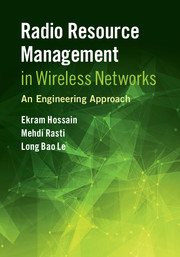Book contents
- Frontmatter
- Contents
- Preface
- Part I Basics of Wireless Networks
- 1 Introduction
- 2 Wireless Networks and Resource Allocation
- Part II Techniques for Modeling and Analysis of Radio Resource Allocation Methods in Wireless Networks
- Part III Physical Layer Resource Allocation in Wireless Networks
- Part IV Link Layer Resource Allocation in Wireless Networks
- Part V Cross-Layer Modeling for Resource Allocation in Wireless Networks
- Index
- References
1 - Introduction
from Part I - Basics of Wireless Networks
Published online by Cambridge University Press: 11 May 2017
- Frontmatter
- Contents
- Preface
- Part I Basics of Wireless Networks
- 1 Introduction
- 2 Wireless Networks and Resource Allocation
- Part II Techniques for Modeling and Analysis of Radio Resource Allocation Methods in Wireless Networks
- Part III Physical Layer Resource Allocation in Wireless Networks
- Part IV Link Layer Resource Allocation in Wireless Networks
- Part V Cross-Layer Modeling for Resource Allocation in Wireless Networks
- Index
- References
Summary
Basics of a Wireless Communication System
Wireless connectivity is one of the most prominent features of modern communications. A basic wireless communication system consists of three main components: transmitter, wireless medium, and receiver. The transmitter transforms the information into physical signals and transmits it over a transmission medium. The wireless medium, which is also called the communication channel, carries the signal, e.g., the free space carries the electromagnetic waves. The receiver receives physical signals from the medium and converts them into information. Usually, the medium corrupts and distorts the transmitted signal. The aim of any communication system is to obtain the transmitted information at the receiver with the lowest possible error rate. Figure 1.1 depicts the block diagram of a digital communication system. For successful multiuser communication, specific network structures and protocols need to be employed.
Electromagnetic Spectrum and Frequency Range
To transmit information over free space, electromagnetic waves are used. The properties of electromagnetic waves vary with frequency, and each frequency band is suitable for certain applications. The natural electromagnetic spectrum consists of a wide range of frequencies, starting from a few Hz up to 1022 Hz. Figure 1.2 lists the frequency bands in the electromagnetic spectrum along with the corresponding applications.
Wireless communication is usually possible in a specific frequency range called the radio frequency (RF) band. The RF band consists of frequencies as low as 30 MHz up to 30 GHz. One advantage of RF band is, for most of the part of this band, relatively small antennas can be used to receive and transmit electromagnetic signals. When impinging on the earth's atmosphere, the RF signals penetrate the ionosphere and the earth's curvature does not hinder the transmission. The low-frequency RF signals, i.e., shortwave signals, are reflected by the ionosphere and thus can be used to broadcast signals.
While military use of the RF spectrum may vary in different countries, the International Telecommunications Union (ITU) allocates and standardizes the commercial spectrum worldwide. The commercial spectrum bands can be divided into licensed and unlicensed bands.
Information
- Type
- Chapter
- Information
- Radio Resource Management in Wireless NetworksAn Engineering Approach, pp. 3 - 48Publisher: Cambridge University PressPrint publication year: 2017
